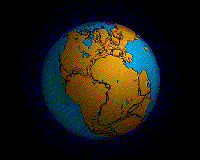The Mesozoic Era

Rendition of a possible Mesozoic Era scene

The breakup of Pangaea
The Mesozoic Era began at the end of the Permian-Triassic Extinction Event about 252.17 million years ago and continued for about 186 million years to end at the K-T Boundary of the Cenozoic Era, about 65 million years ago. The Mesozoic Era has been characterized as The Age of Reptiles due to the relative prevalence of reptilian creatures throughout the geological record. The vast majority of reptilian species on the planet died off during the Cretacious-Paleogene Extinction Event at the end of the Era.
It has been estimated that between 90% and 96% of all marine species and 70% of terrestrial vertebrates became extinct during the Permian-Triassic Extinction Event that marked the beginning of the Mesozoic Era. It was a time of increased global surface temperatures, higher levels of ultraviolet radiation reaching the surface and massive amounts of carbon dioxide and noxious gases being pumped into the atmosphere. The increase in carbon dioxide levels made the oceans more acidic and species with calcium carbonate skeletons took the biggest hit as their skeletons dissolved in the water. In the end, the Great Dying set the stage for the ascendance of reptiles.
The Age of Reptiles
Laramide and Sevier Orogenies
63-65 million years ago
Overlapping mountain building events in the western US and Canada: the Basin and Range Province is built, the Ancestral Rockies and the Colorado Plateau pushed up
Cretaceous-Paleogene Extinction Event, K-T Boundary
65 million years ago
Asteroid impact near the Yucatan peninsula, postulated to have combined with on-going geological and atmospheric processes to cause global climatic conditions that wiped the dinosaurs out
Cretaceous Period
63-145 million years ago
Laurentia was an independent continent known as North America. Age of the dinosaurs, early mammals appear
Nevadan Orogeny
140-180 million years ago
The breakup of Pangaea and the collision of Laurentia with the Pacific plate cause volcanic disruption: stratovolcanoes up to 20,000' high along the subduction zone, volcanoes that erode and expose their granitic basement now as the Sierra Nevada Mountains
Jurassic Period
145-201.3 million years ago
Pangea split into minor supercontinents Laurasia and Gondwana, Laurentia was part of Laurasia. Age of the large terrestrial dinosaurs
Triassic-Jurassic Extinction Event
201.3 million years ago
50% of all species on Earth die off, paving the way for the explosion of dinosaurs
Triassic Period
201.3-252.17 million years ago
The supercontinent Pangaea. Terrestrial species emerge, diversify and grow
The Mesozoic Era was a time of significant geological, climatic and evolutionary activity. The supercontinent Pangea slowly rifted apart and the continents of today emerged, almost as they are today. The climate varied greatly between hot and cool but generally, the atmosphere was warmer than it is today. Late in the Triassic Period non-avian dinosaurs began to appear and they became the dominant terrestrial vertebrates for 135 million years, through the Jurassic and Cretaceous Periods until they died off during the Cretaceous-Paleogene (K-t) Extinction Event.
Avian dinosaurs first appeared during the Jurassic and many species of avian dinosaurs survived the K-T Event. The first true mammals appeared during the Early Jurassic but remained small (less than 30 pounds) through the end of the Mesozoic, surviving the K-T Event and rising to become the dominant terrestrial vertebrates during the Paleogene Period.

Rendition of a sericipterus, an avian dinosaur from the Jurassic Period
Upper image courtesy of Gerhard Boeggemann, CCA-by-SA 2.5 License
Animation courtesy of the USGS
Lower image courtesy of Nobu Tamura, CCA-by-SA 3.0 License